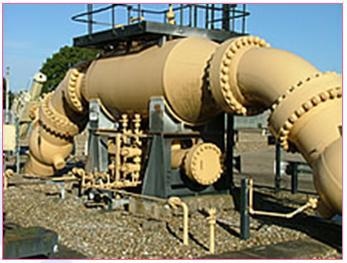HIC steel is plate which is tested to reduce the effects of hydrogen induced cracking in a wet H2S or sour service environment.
Features of Hydrogen Induced Cracking (HIC) Steel
MASTERHIC is Masteel UK Limited's designation for HIC Steel for fine grain pressure vessel steels offering specific and superior properties for sour gas application. HIC resistant steel is manufactured via the electric arc furnace with desulphurisation, dephosphorisation, ladle refining and vacuum degassing to provide an ultra clean and homogeneous steel. HIC steel is particularly suited for pressure equipment where wet H2S corrosion can be a problem. ASTM/ASME A/SA 516 60/65/70 in accordance with MASTERHIC 5/10/15 HIC Resistant Steel for Pressure Equipment in Sour Service.

What is Hydrogen Induced Cracking (HIC)?
Hydrogen Induced Cracking (HIC) occurs when carbon steel is exposed to hydrogen sulphide (H2S) and is the direct result of electrochemical corrosion reactions between the sour service or wet H2S environment.
Hydrogen Induced Cracking (HIC) in the Oil and Gas Industry
Particularly common to the Oil and Gas Industry where the use of steel pressure vessels is widespread, the risk of this should be considered when hydrogen sulphide partial pressure becomes greater than 3.5mbar. Carbon steel pressure vessels should not be affected by HIC damage where H2S levels are lower than this figure in a normal service life cycle. HIC is prevalent in wet H2S environments, which is often known as sour service and such cracking over a prolonged period of time without inspection, will reach a critical point and the steel component i.e. pressure vessel, could easily fail.Simply put, hydrogen induced cracking damage increases as the level of hydrogen sulphide increases.

Stress-Orientated Hydrogen Induced Cracking (SOHIC)
Susceptibility to hydrogen blistering and hydrogen induced cracking can be apportioned to the quality of the steel plate used. Another type of hydrogen corrosion, Stress-Orientated Hydrogen Induced Cracking (SOCHIC), is normally found in the base metal adjacent to the weld, where the stress point is highest due to the internal pressure of the vessel and the stress on the weld point itself. HIC and SOCHIC can also be found in steel pipework.
This represents a major problem for the oil and gas industry - it is no coincidence that many facilities employ dedicated corrosion engineers who rigorously inspect pressure vessels for signs of wear and corrosion.
Masteel are experts in the supply of the highest quality HIC tested carbon steel plate for pressure vessels and boilers and have a stockholding at their UK distribution warehouse.
Why Choose Hydrogen Induced Cracking Tested Steel Plate?
Masteel supply HIC tested steel plate to high end customers in the Oil ,Gas and Petrochemical Sectors. These customers demand the highest standards in terms of quality, durability and performance.
Economic Benefits of Hydrogen Induced Cracking Tested Steel Plate
HIC tested steel plate is the ideal choice for pressure vessels and boilers in this particular market as it is tested for resistance against hydrogen induced cracking. It is deemed to be the most sensible and cost effective solution, since standard carbon steel plate is more prone to hydrogen sulphide corrosion in wet H2S and sour service environments, and is a far more cost effective alternative to stainless steel.
Test for Hydrogen Induced Cracking
In essence, HIC testing is actually an evaluation of the steel for susceptibility to hydrogen embrittlement. The test procedure involves the evaluation of resistance of pressure vessel steel plate and pipework steels to hydrogen reduced cracking caused by hydrogen absorption from aqueous sulfide corrosion. An unstressed steel sample is exposed to a solution at ambient temperature and pressure and after a designated period, the sample is removed and assessed.
HIC Resistant Steel - Grades & Equivalents
Below are technical details of our HIC (hydrogen induced cracking) resistant steel plate, including information relating to testing and identification.
Table 1. Testing on different grades of MasterHIC steel
|
Description
|
CLR (%)
|
CTR (%)
|
CSR (%)
|
|
MASTERHIC 5
|
≤ 5
|
≤ 1.5
|
≤ 0.5
|
|
MASTERHIC 10
|
≤ 10
|
≤ 3
|
≤ 1
|
|
MASTERHIC 15
|
≤ 15
|
≤ 5
|
≤ 2
|
MASTERHIC 5/10/15 is tested in accordance with
NACE TM 0284-03 with test solution A (pH =3)
Chemical Analysis of HIC Resistant Steel
The limits on unspecified elements of ASTM/ASME A/SA 20 Table 1 are not exceeded. For product analysis the admissible deviations from the indicated values for P and S are to be agreed.
Custom-Made Steel Pressure Vessel
Our HIC tested steel plate is either tested at the mill or by an independent UKAS approved testing agency. However, as the steel we supply is generally for very high quality usage, our customers usually specify the test criteria themselves. Masteel can also help you formulate a test criteria for your pressure vessel steel. As far as is technically possible, your inspection and acceptance requirements can be tailored to your individual requirements.

This information has been sourced, reviewed and adapted from materials provided by Masteel UK Ltd.
For more information on this source, please visit Masteel UK Ltd